Fusion Science Program

Plasma experiments
In this program, research supervision focused on fusion relevant plasma based on experiments using a large fusion experiment device and basic plasma based on experiments using small devices is provided .
LHD:Large Helical Device
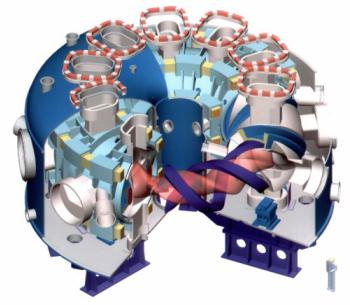 |
The LHD is a fusion experiment device in the National Institute for Fusion Science. A donut-shaped plasma (represented by light purple in the figure) is confined by a magnetic field produced by the helical coils (purple) and the poloidal coils (yellow), both of which are made of superconductors with a maximum field strength of about 3 tesla. The helical coils consist of two coils, while the poloidal coils consist of six coils with three each at the top and the bottom of the torus, as shown in the figure. The major and (averaged) minor radii of the device is 3.5 to 4.1 m and ~0.6 m, respectively. It is the largest device in the world as a magnetically confined device with a helical type magnetic field. The plasma is heated up to one hundred million degrees Celsius at maximum, using a neutral beam injection (NBI), electron cyclotron resonance heating (ECRH), and ion cyclotron range of frequency (ICRF) heating. Hydrogen, as a fuel gas of the plasma, is supplied by an iced pellet injection or by a gas puff system. Various diagnostic systems are installed in the device, as described below. |
Plasma Physics and Control
In order to realize a fusion reactor in a magnetically confined device, it is necessary to maintain a high temperature (~ one hundred million degree Celsius)and a high density (~1020 m-3) plasma for more than one second. In this course, we study key issues required to control the fuel, and others. The research issues consist of production of a fusion relevant plasma, control of temperature, density and impurity content in the plasma, optimization of magnetic field structure, injection/pumping of plasma particles, and plasma-wall interaction, which are based upon physical understanding of plasma equilibrium/instability, transport processes, and balances of energy and particles. We study these issues aiming at developing an integrated control system for the fusion plasma.
(a)Production of high density and high temperature plasmas
Helical devices have an advantage over tokamaks in a high density operation. This is because the helical device not require a toroidal current and is thus free from a disruptive instability (disruption). In tokamaks, on the contrary, the toroidal current is a prerequisite for creating the confinement magnetic field, and an achievable operating density is found to be related to the magnitude of the current. A high density operation can mitigate an excessive rosion of the plasma facing components of the devices, and thus eases engineering constraints on the plasma facing material. Also the high density operation can mask a detrimental effect of the neo-classical transport that is specific to the helical devices. In these contexts, explorations of high performance operation with the high density toroidal current-free plasma is one of the most important issue for establishing high density operation scenarios in helical reactors.
The recent experiments in the LHD have demonstrated that a combination of efficient pumping and effective core fueling realizes an internal diffusion barrier, which results in a super dense core plasma of more than 1021 m-3. This achievement opens a new operating scenario for a high density reactor operation. At the same time, new research topics emerge, such as a physics mechanism of the internal diffusion barrier, applicability of the barrier to the reactor condition, and an operating space (limit) of super dense plasmas.
It is also important to achieve a high ion temperature for realization of the nuclear fusion condition. In the LHD, a central ion temparature as high as 94 million degrees Celsius has been successfully obtained. It has been found that in such a high ion temperature operation the plasma rotation profile changes significantly; a relationship between the rotation profiles and energy transport is currently being investigated. During the high ion temperature operation, an interesting phenomenon, the reduction of carbon impurity content in the core region, has also been observed.

(b) Research on magnetic field equilibrium and magnetohydrodynamic (MHD) instabilities
The nuclear fusion plasmas are confined by a “basket” of the magnetic field (equilibrium magnetic field). In order to obtain a high plasma confinement or a good MHD stability, the equilibrium field has to be optimized. In addition, an optimization of the equilibrium is explored also for realizing a high beta (β) value (a ratio of plasma pressure to magnetic field pressure). In the LHD, a maximum beta value has been updated year by year in a course of optimization of the equilibrium field by adjusting the magnetic field axis and the plasma radius, and recently a value of 5% has been achieved. In high temperature and high density plasmas, it is well known that a kind of MHD instability is driven, in which plasma escapes across the magnetic field. In the LHD, the MHD instability has been detected when the β value exceeds ~ 3%, while no remarkable deterioration in the plasma confinement is observed. The β value could then be increased further, and finally we could obtain a stable high beta operation for a duration more than 50 times the energy confinement time without any disruptive instabilities. In a theoretical study, detailed numerical simulations are being conducted for an optimum equilibrium field, under a comparative study with experiments.
 The change of the magnetic field structures caused by an increase in plasma pressure.
The change of the magnetic field structures caused by an increase in plasma pressure.(c) Plasma facing materials, plasma-surface interactions and divertor plasma<
In nuclear fusion research the improvement of plasma confinement has been achieved by controlling peripheral plasmas, such as the improvements of the surface condition of plasma facing components and the creation of divertor magnetic field configuration. It is also said that one of the most important issues for realization of a nuclear fusion reactor is the wall design.
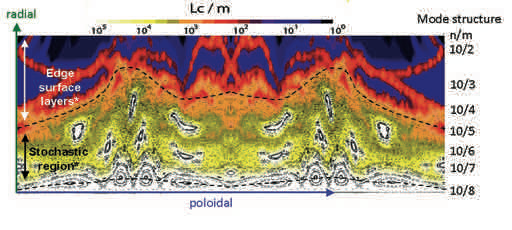
In a fusion reactor, a large amount of energy and particle flux is expected to emerge from the confinement region and reach the plasma facing components. Therefore, the control of the energy and particle flux is a very important issue in order to avoid fatal damage to the plasma facing materials (the first wall and the divertor plates), together with achievement of a good pumping efficiency of Helium ash and a sufficient fuel injection, while all these issues must be compatible with a high performance core plasma. An understanding of the energy and particle transport in the peripheral plasma is a prerequisite for realizing mitigation of the excessive energy and particle loads on to the plasma facing components. For control of the plasma and for a sufficient lifetime of the first wall and the divertor plates, the following topics are also of vital importance: study of the erosion and damage of the plasma facing components; impurity production and its transport; the recycling process of fuel species, and others. The research topics related to the plasma wall interaction are evaluation of wall conditioning with a discharge cleaning and coating of the material surface, understanding and control of erosion and re-deposition processes of the first wall and the divertor plates, and others. These issues become critical especially in a steady state operation in a fusion reactor, and thus are common issues for all magnetic confinement devices. The LHD contributes to the design and determination of the operation scenarios of next-step devices such as ITER through these research topics.
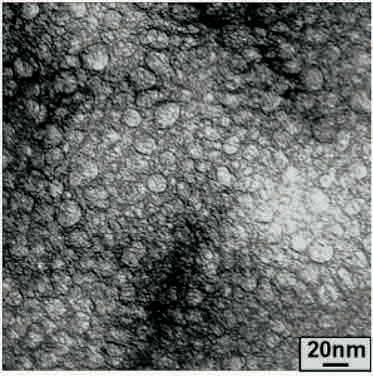
An image of high density gas bubbles created in a plasma facing component (stainless steel), photographed by a Transmission Electron Microscope (TEM).
(d) Research on plasma control
In order to realize a long pulse operation in a fusion reactor with an improved plasma confinement utilizing the super dense core plasma, the magnetic field equilibrium, the plasma density, the plasma heating power, and other conditions must be controlled for a long duration. In the LHD, a real time control of the magnetic field equilibrium during a discharge is being conducted aiming at obtaining a high beta plasma, while avoiding disruptive MHD instabilities. Such experiments can provide new insights into the realization of high beta plasma in future devices. Regarding density control, two technologies have been developed so far as a fuel supply. One is a gas puff, which emits hydrogen as a gas at room temperature. Another is a pellet injection, which shoots iced hydrogen pellets at a very high speed. The LHD is equipped with a gas puff system, which can provide a variation of puff rates 0.01 ~ 240 Pa m3/sec) with a pre-programmed or with a density feedback control system. It is also equipped with a high speed, repetitive pellet injection system. These systems contribute to particle transport study, and also enable us to achieve super dense plasma and high beta plasma through precise control of the fueling rate and efficiency.
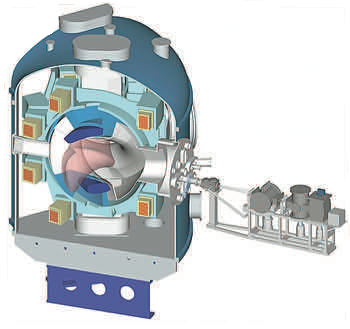 The pellet injection system in the LHD.
The pellet injection system in the LHD.Plasma Heating
Plasma heating physics and engineering development of plasma heating devices are studied. In plasma heating physics, plasma breakdown, high power plasma heating, current drive mechanism, and effects on the plasma confinement properties are investigated. In engineering development, high power neutral beam production, generation and transport of high power microwaves, and the optimization of the launcher are being developed. The LHD has adopted three types of plasma heating schemes. The first is neutral beam injection (NBI) heating. Hydrogen neutral atoms with high energy are injected into the plasma. The neutral beams are ionized in the plasma and the high energy hydrogen ions heat the bulk plasma. The second is electron cyclotron resonance heating (ECRH). The microwave injected into the plasma resonates the cyclotron motion of electrons in the plasmas and then the electrons are accelerated. And the third is ion cyclotron range of frequency (ICRF) heating. A high frequency wave is excited in the plasma, and then the ions are accelerated by the ion cyclotron resonance. These plasma heating schemes are used for current drive in the plasma as well as production and heating of high temperature plasma in the LHD.
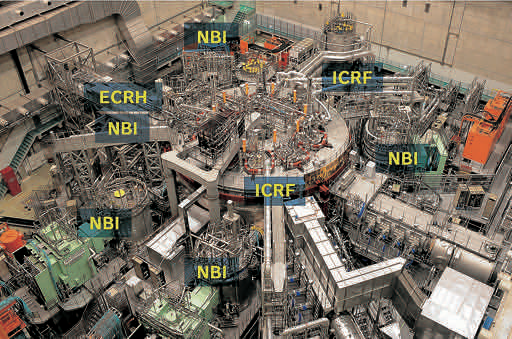
(a) Neutral Beam Injection (NBI)
NBI heating is a plasma heating method using high energy ions in the plasma, and it is a very powerful scheme for production of high performance plasma. The neutral beam is required so to produce energetic ions in the plasma, because the magnetic field for plasma confinement blocks the charged beam injection. In order to achieve effective neutralization of the ion beam, a positive ion source and a negative ion source are developed for relatively lower energy beam production (40 keV – 80 keV) and for high energy beam production up to 190 keV, respectively.
Three negative-ion-based beam injectors are operational in LHD, and two negative-ion sources are mounted in each beam injector. Two positive-ion-based beam injectors are also operational, and four positive ion sources are mounted in each beam injector. The capability of beam injection is 27 MW, and high performance plasma such as high β (β ~ 5.1%) plasma and high ion temperature plasma (Ti0 = 8.1 keV) have been produced by NBI heating in LHD.

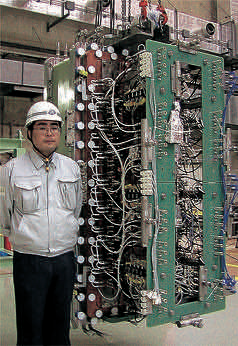
Research topics include transport study of NBI heated high temperature plasma, energetic ion confinement characteristics and the loss mechanism, MHD instability and anomalous loss of energetic ions induced by the MHD instability, development of high performance negative ion source, physics mechanism of negative ion production and their dynamics, RF negative ion source development for ITER, development of highly effective neutralization of energetic ion beam, and others.
(b) Electron Cyclotron Resonance Heating (ECRH)
ECRH is a plasma heating method using electron cyclotron resonance with a microwave. The high power microwave is generated with a gyrotron oscillator and is transferred almost 100m by a corrugated waveguide. Antenna systems are installed in the vacuum vessel of the LHD and control the microwave injection direction. The microwave launched from the antenna system has a Gaussian shape with a diameter of 5 cm at the plasma center. An electron internal transport barrier (ITB) has been formed in the core region and the high electron temperature beyond T e0=20 keV has been realized with ECRH plasmas to date. Recently, the pulse duration of gyrotron operation has become longer, and the steady state plasma discharge with the duration longer than 1 hour was also realized with ECRH.
The research topics of the ECRH group include plasma confinement properties and electron heat characteristics in the ECRH plasmas, physical mechanism of the formation of electron ITB, current driven by ECRH and control of the iota profile, electron Bernstein mode conversion and “over-dense” plasma heating, behavior of high energy electrons and their effect upon bulk plasma confinement, development of high power and long pulse gyrotron oscillators, development of microwave transport system with high transport efficiency, development of antenna systems, and others.

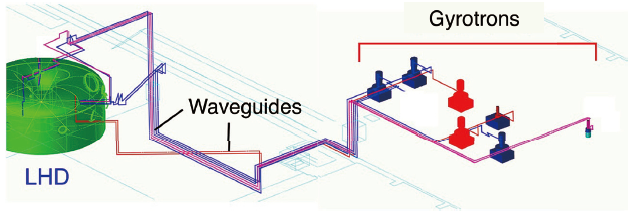
(c) Ion cyclotron range of frequency (ICRF) heating
ICRF is a heating method using radio frequency waves which have a frequency close to ion cyclotron frequency and mainly accelerates ions in the plasma. It is not suitable to heat ions with direct ion cyclotron resonance in magnetized plasmas. Therefore, the ions are heated by the minority ion heating method, higher harmonic heating method, and other methods. Ion Bernstein wave heating method through the mode conversion is also being developed, which is a very interesting and fundamental subject in plasma physics.
An improved ICRF antenna system aimed at longer- and higher-performance in steady state plasma operation has been installed in LHD. The radio frequency wave with a variety of frequencies is supplied for the study of the minority heating, the second harmonic heating of hydrogen ions, electron heating through mode conversion, the ion Bernstein wave heating, and other procedures.
The research topics of the ICRF group are confinement characteristics of ICRF heating plasma, confinement of energetic ions accelerated by ICRF, electron heating mechanism through mode conversion, long pulse plasma heating and steady state plasma operation, development of a radio frequency system with high power and steady state operation, development of high efficiency antenna system, development of feedback control of impedance matching, and others.
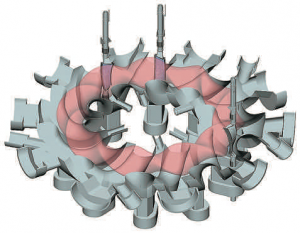
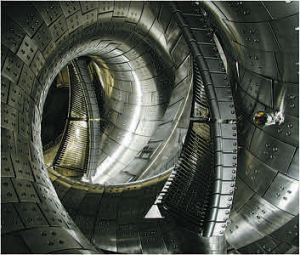
Diagnostics
The measurement of plasma parameters is important for understanding the fusion plasma characteristics and, consequently, for realizing the fusion reactor. The LHD is equipped with a number of diagnostic tools which help us obtain various types of physical quantities of the plasma. Specifically, the essential parameters, such as temperature, density, and confinement time, are simultaneously obtained from the measurements, and a comprehensive analysis of those parameters shows us clues for the improvement of plasma performance.
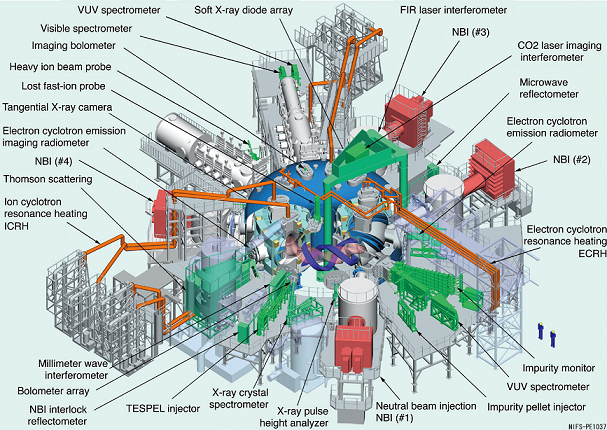
Some diagnostic tools, such as the electrostatic probes, must be inserted into the plasma, for the measurement and the use of those devices is limited to the measurement of the plasma edge region where the temperature is low because those probes are damaged by the plasma and therefore perturb the plasma to be measured. Therefore, most plasma diagnostics are based on non-invasive methods which are typically categorized into two groups: passive and active methods. The observation of electromagnetic waves and particles emitted from the plasma is an example of passive methods. Active methods are represented by the measurements of plasma reactions to the laser, microwave, or particle beam injected into the plasma.
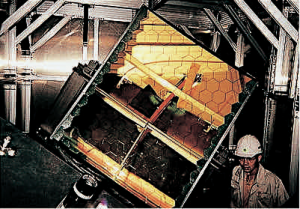
- Magnetic fluctuation measurement
- Electron cyclotron emission measurement
- Energetic particle measurement
- Visible light spectroscopy
- X-ray radiation measurement
The plasma diagnostics are continuously developing by novel ideas and cutting edge technologies.
- Heavy ion beam probe measurement
- Microwave reflectometry
- Thomson scattering measurement
- Collective Thomson scattering measurement
- Far infrared laser interferometry
- Divertor interferometry
- Charge exchange spectroscopy
- Diagnosis with TESPEL
(Tracer-Encapsulated Solid Pellet)
Ion temperature measurement
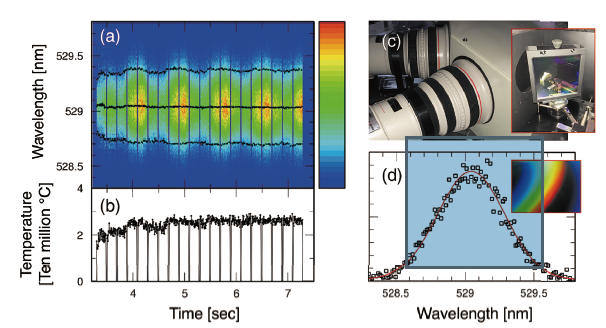
For the measurement of the plasma temperature the light radiated from the plasma can be used. Various energy (color) ranges of light are emitted from the plasma. The light is resolved into the energy spectrum by a spectrometer and a specifi c emission line which has information on the temperature is extracted. The emission line shape is broadened by the Doppler eff ect so that the plasma temperature is evaluated from the broadening width of the emission line. The ion temperature measurement is one of the most important diagnostics by which we can know the degree of our achievement toward the realization of a nuclear fusion reactor.
Imaging measurement
It is difficult to infer the plasma conditions in the deep inside area only from the information available at the outside of the device. Recent diagnostic techniques have made progress on that problem, and the measurement of the one-dimensional radial distribution of physical parameters in a plasma cross-section has been established.
The development of two-dimensional detectors such as the CCD and large-scale data processing techniques has further extended the spatial distribution measurement to the two-dimensional or imaging measurement. The result of the imaging measurement shows a still image of a plasma cross-section taken by a special camera which enables us to see various complicated facets of the fusion plasma.
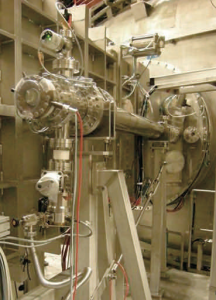
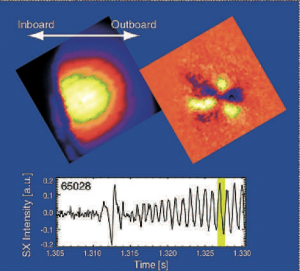
The development of plasma diagnostics is a continuously advancing research field. It is exciting to find new phenomena which no one has ever seen with a diagnostic tool developed by oneself. Recently, applications of diagnostics developed for the fusion plasma for industrial research are active. The outcomes of the research at NIFS will also play an important role in those fields.
Basic Plasma
The three main research activities in NIFS are: (i) Large Helical Device (LHD) experiment; (ii) Numerical simulation; and (iii) Fusion engineering. In addition, NIFS has several support devices with which various fundamental research projects considered to be useful in broad areas of plasma science are being performed as collaborative research with numerous universities in Japan.
Basic plasma experiments using a small device have the strong appeal of the plasma being visible to the naked eye. Further, researchers and graduate students may design experiments as they like, which is not generally feasible with large devices. If one wishes to pursue a professional career in fusion research, these experiences as a graduate student will be meaningful. In addition to the experience gained, it is possible to make a new discovery in basic plasma science, for which many collaboration studies are underway.
Basic plasma experiments in HYPER-I
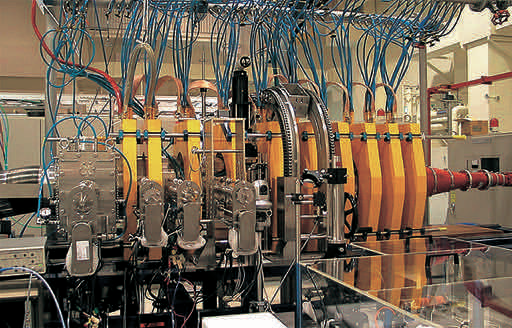
The HYPER-I device (Fig. 1) consists of a cylindrical vacuum chamber, which is 30 cm in diameter and 2 m in length, and a set of ten magnetic coils that produce a weakly-diverging magnetic field configuration. HYPER-I can produce high density (> 1019 cm-3) steady plasmas by electron cyclotron resonance heating with a 2.45 GHz microwave whose maximum power is 80 kW. By injecting the right-handed circularly polarized microwave from the high field side, the maximum attainable density significantly exceeds the cutoff density of ordinary waves.
Since the plasma is a collection of a large number of charged particles, various collective motions are formed by electromagnetic interactions. In fact, spontaneous formation of several large-scale flow patterns, or vortices, is frequently observed (Fig. 2).
In order to understand the formation mechanisms of those vortex structures, spatial distributions of many physical quantities (temperature, density, space potential, flow velocity, etc.) must be measured. So far, particle measurements using various probes are the main diagnostics in the HYPER-I device (Fig. 3). However, recent efforts focus on spectroscopic measurements using lasers. Laser measurement has advantages in that it gives little disturbance to the plasma and provides the absolute value of flow velocity. Moreover, information on neutral particles can also be obtained by laser measurement. Therefore, this research may change earlier views regarding vortex formation in which only the interaction between electrons and ions is taken into account. Progress in this field likely will come from the consideration of interaction between plasma and neutral flow.

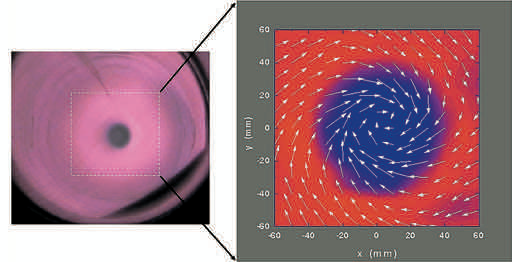
Fusion Reactor Engineering
Research on development of superconducting magnet
In the field of Fusion Reactor Engineering, the two essential research issues, superconducting magnet engineering for a high confinement magnetic field and development of advanced blanket systems for power generation and fuel breeding, are being promoted. In addition, academic research for a wide range of industrial fields beyond fusion engineering is being conducted through cutting-edge technological development for the fusion system.
System design for the helical fusion reactor, such as the helical DEMO reactor, is also ongoing through international collaborations. In that framework, research and development concerning the fusion system design, the optimum confinement magnetic field configuration, the engineering design of the superconducting magnet system, the design of the support structure of the magnetic coils, and the blanket system are being promoted.
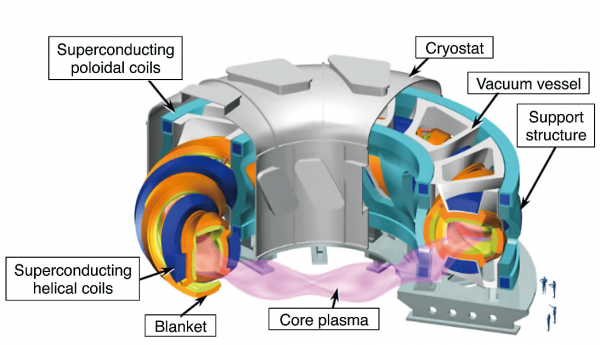
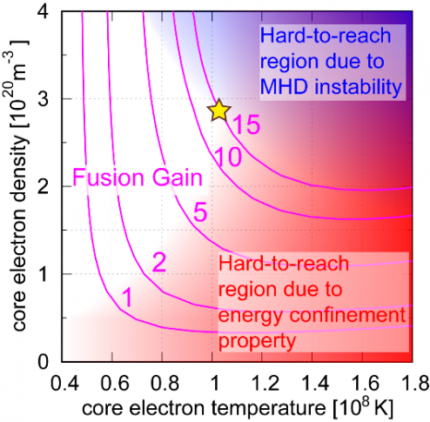
Research on Applied Superconductivity and Cryogenic Engineering
The large-scale magnet system for the fusion reactor requires high-performance superconductors with 100 kA-class current capacity. Research is being conducted for developing such an advanced conductor made of metallic low-temperature superconducting (LTS) materials as well as of copper-oxide high-temperature superconducting (HTS) materials.
By combining LTS strands, large-current capacity conductors are being developed to enhance the present performance used in superconducting fusion devices, including LHD and ITER. In addition, the conduction-cooled conductor is also being investigated for its feasibility. State of the art HTS tapes are used to assemble a 100-kA-class stacked-type conductor. For strands, low activation materials are also being investigated.
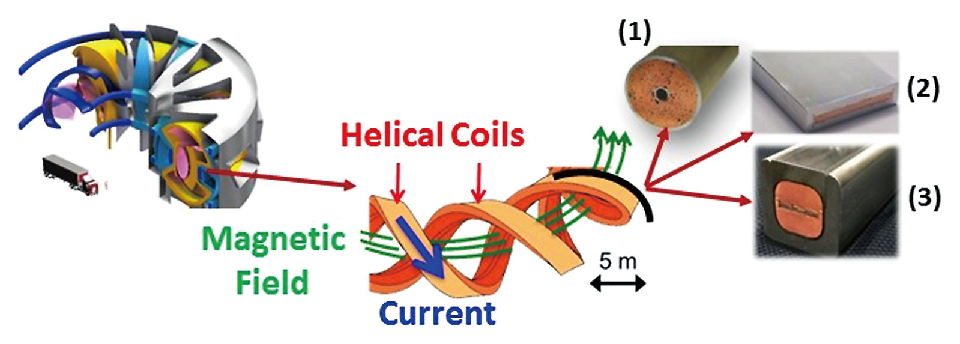
Three kinds of large-scale superconductors developed for the magnetic coils of the helical fusion reactor: (1) LTS CIC (cable-in-conduit) conductor (photo: the ITER-TF conductor), (2) LTS conductioncooled conductor, and (3) HTS STARS (Stacked Tapes Assembled in Rigid Structure) conductor.
Components in fusion magnet systems are subjected to intense electromagnetic forces. Research is ongoing so as to precisely evaluate the expected stress on component materials and to seek the optimum coil supporting structure. The engineering design of the coil winding and fabrication method is also in progress.
To cool superconducting magnets, large-scale cryogenic systems are indispensable, and cryogenic engineering is an important research field. For the demo fusion reactors, various cooling methods are being investigated, such as liquid helium, supercritical helium, superfluid helium, gaseous helium, and conduction cooling. Their characteristics are being investigated in experiments and numerical simulations.
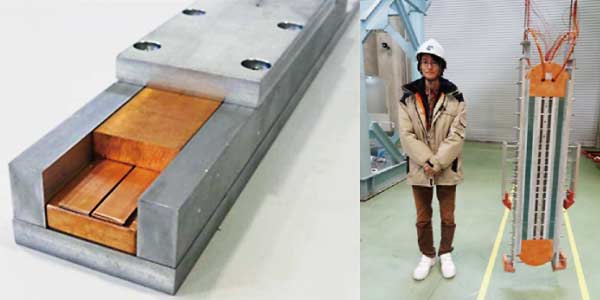
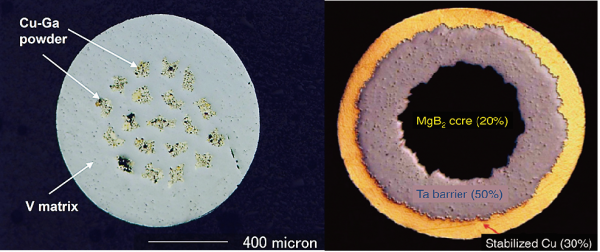
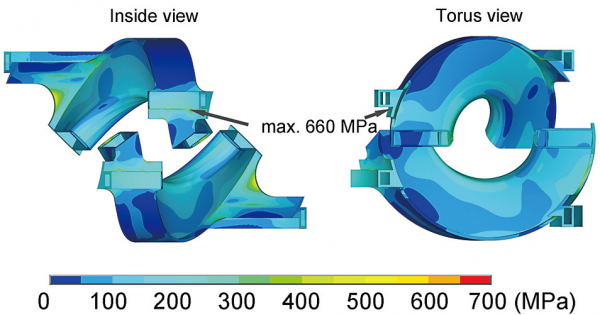
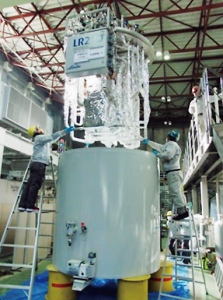
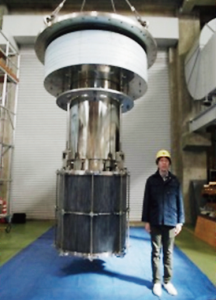
Research on development of advanced blanket systems
The activities for fusion reactor designs and experiments are strongly coupled in the Fusion Engineering Research Project (FERP). In a fusion reactor, a core plasma is surrounded by thick components called “blanket.” The blanket converts the energy of fusion neutrons from the core plasma to thermal energy, and the reactor then generates electricity. Academic research is being conducted for development of long-duration advanced blanket systems which adopt molten salts or liquid metals as fuel breeders/coolants.
Research on fusion blanket design
A fusion blanket receives fast neutrons generated in a core plasma. Conversion of neutron energy to thermal energy, tritium fuel breeding, and radiation shielding are required functions to be performed efficiently in a blanket. Optimization of material combination and configuration for the blanket systems, and design of blanket components for a helical-type fusion reactor are being investigated by numerical calculations reflecting progress in material and system development. Validation of the investigations is performed by experiments in collaboration with universities, the Japan Atomic Energy Agency (JAEA), and other organizations.
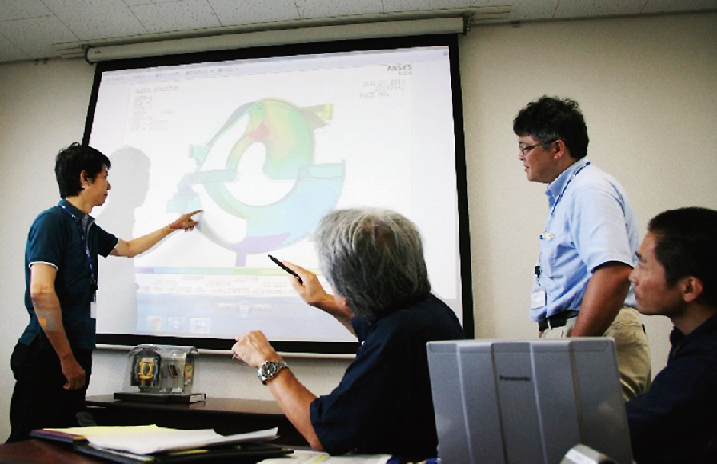
Integrated research on liquid blanket technologies and systems
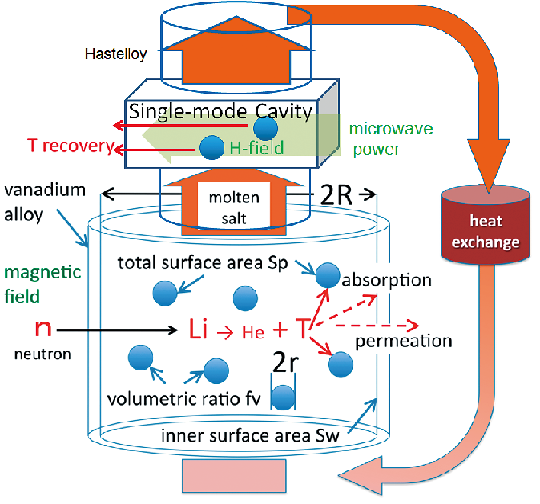
A model of hydrogen transfer control in a moltensalt coolant by mixed metal nano-powders
In parallel with fundamental studies on properties of liquid fuel breeder/coolants and technologies for blanket systems, integrated experimental studies have been started with the newly constructed Flinak/LiPb twin-loop OROSHHI-2 (Operational Recovery Of Separated Hydrogen and Heat Inquiry-2). Compatibility of materials, control of coolant flow, transfer and recovery of heat and hydrogen, and other topics can be studied by simulating a blanket temperature (300- 550 ℃ ), coolant flow velocity (up to 1.5 m/s), and high magnetic field by using the 3 T super conducting magnet (the world’s highest magnetic field for this purpose). Topics of focus at present are non-equilibrium mass and heat transfer in the circulated coolants, control of hydrogen transfer by mixed metal nano-powders, and others.
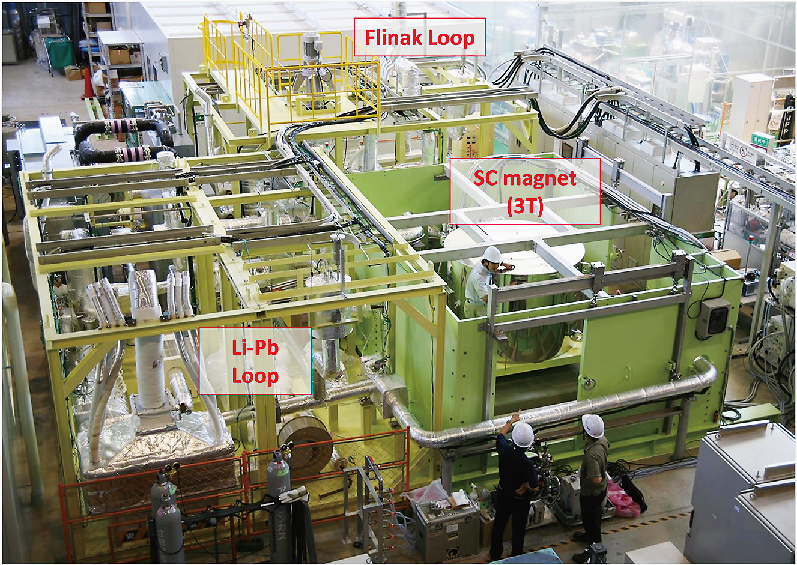
Research on development of structural materials
Since a blanket is irradiated by high-energy neutrons during reactor operation, low activation materials, the radioactivity of which decays quickly after reactor shutdown, must be used for the fabrication. NIFS is leading the development of vanadium alloys as a promising candidate.
The low activation vanadium-alloy “NIFS-HEAT” has been produced for round-robin testing of property evaluation and studies on blanket fabrication technologies. Fundamental research for property improvement has been conducted in collaboration with universities.
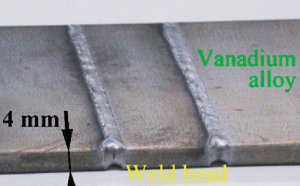
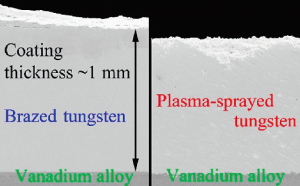
Research on functional and advanced materials
Ceramic coating technologies have been studied for suppression of MHD (Magnetohydrodynamics) pressure drop, that is, electromagnetic brake, in liquid metal coolant flowing across a magnetic field and also for suppression of hydrogen fuel permeation through high temperature blanket components. Activities for development of advanced fusion materials are expanding the topics to ODS (Oxide Dispersion-Strengthened) Cu alloys for efficient divertor cooling, ODS steels for advanced blanket systems, neutron shielding materials, and others, with a newly installed HIP (Hot Isostatic Pressing) apparatus.
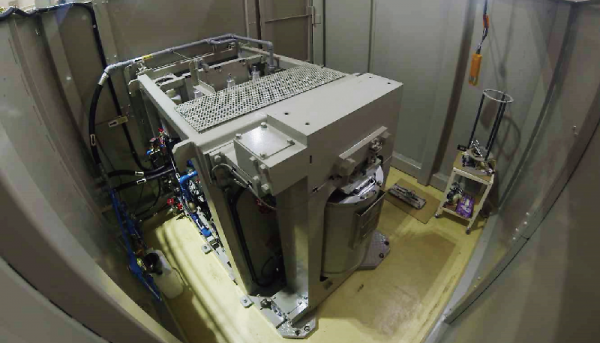
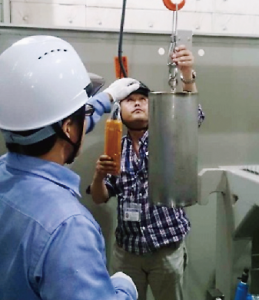
Radiation Safety Engineering
Our research group studies and develops radiation safety management, tritium handling technology, and environmental radiation research around the fusion facility. In the future fusion reactor, tritium will be utilized as fuel, and radiation such as neutrons will be generated by fusion reactions. Tritium is a radioactive isotope and the neutron generates the activation products. From the viewpoints of radiation management and public acceptance, there are various research topics such as recovery and separation of hydrogen isotopes, new concepts of radiation protection and radiation measurement in the work environment, techniques for environmental impact assessment, design of fusion system safety, and others. Also, these topics will be connected with the radiation safety management of the deuterium plasma experiment by the LHD.
Study of radiation protection in the fusion facility
Neutrons generated by fusion reactions activate the material in the fusion device and other equipment in the fusion facility. Then, the radioactive materials activated by neutrons distribute in the work environment. To make a working plan after activation, it is necessary to predict and understand the space-time distribution of radioactive materials.
The distribution of radioactive materials is predicted by a neutron particle transport calculation code. Then, the intensity distribution of radiation is calculated from the calculation results of the activation. Regarding the radiation measurement, the visualization measurement device of radiation source at a distant place is being developed to measure activation materials. We are discussing a suitable radiation work plan using the calculation results and the radiation measurements.
Recovery and separation of hydrogen isotopes
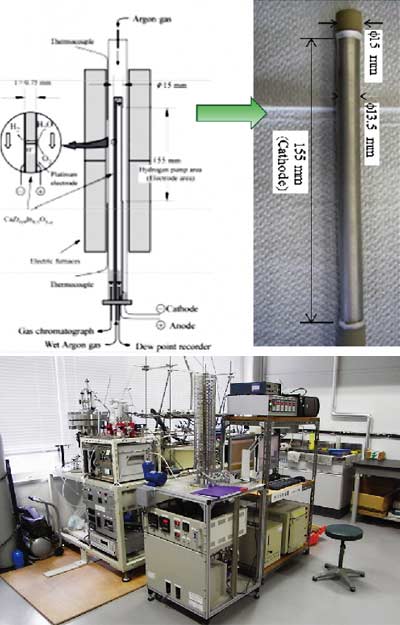
Tritium and deuterium will be utilized as fuels in the future fusion reactor. The burning rate in the core plasma is designed to be a few percent. Thus, the unburned hydrogen isotopes must be recovered from the exhaust gas for fuel recycling. Recovered hydrogen isotopes are purified and separated for reusing. These processes are called the “fuel cycle system.” To realize the fusion reactor, the development and establishment of the fuel cycle system is one of the important issues.
The membrane separator systems are investigated for the purification of hydrogen isotopes. For example, the application of a high temperature type solid-state protonconducting membrane has been proposed as the electrochemical hydrogen pumping system. It has attractive advantages such as hydrogen extraction from both hydrogen molecules and hydrogen compounds, control by electric current, no pressurization, processing in gaseous state under elevated temperature, and others. In this research topic, the one-end closed tube type of the proton-conducting membrane is utilized from the viewpoint of practical use. Then, the performance of the electrochemical hydrogen pump and the behavior of charge carriers in the proton conductor are investigated. The experiments using tritium gas are conducted in the isotope separation laboratory at Nagoya University.
Development of advanced tritium removal system
When tritium gas leaks in an experiment room, it is necessary that this gas be recovered as soon as possible by a tritium removal system. A conventional tritium removal process is to convert hydrogen and methane gases to water by an oxidation catalyst and to dehumidify with an adsorption bed. The conventional bases of catalyst and adsorption materials were ceramic particle packed beds. However, high throughput of air caused a large pressure drop in the packed bed. Thus, we propose the honeycomb shape samples which are of a low pressure drop. To design the tritium removal system, it is important to understand the performance of honeycomb shape catalysts.
A series of honeycomb-shape substrates made by ceramics and metals as the oxidizing catalysts are being developed with particular companies. The characterizations of the catalysts are analyzed by the electron microscopes, the adsorption isotherm method for surface area, pore size distribution measurements, and other methods. The oxidation performances of the catalysts are evaluated by the original fixed bed catalyst reactor under the various gas compositions and experimental conditions. Then, we consider the catalyst properties from the aspect of chemical kinetics.
New technique for gaseous tritium monitoring
The detection of low level tritium is one of the key issues for tritium management in tritium handling facilities. Various types of tritium monitors, such as ionizing chambers, proportional counters, and scintillation-type detectors, have been developed. Tritium emits low energy beta particles, and the detection of tritium in the presence of other radionuclides such as 41Ar and 222Rn is a particular challenge since higher-energy radiation is generated by these nuclides rather than by tritium. The detector response to radiation from these other species generally obscures the detector response to tritium.
A new tritium gas monitor is being developed by applying several techniques. As one of the techniques, a pulse-shape analyzer method to eliminate noise pulses that affect tritium measurements is utilized as the signal-processing unit of the tritium gas monitor. The experiments using tritium gas are conducted in the isotope separation laboratory at Nagoya University.
Other research themes
- Design of radiation safety management system for the fusion facilities
- Study of hydrogen isotopes behavior and mass balance in a fusion system
- Investigation of the environmental behavior of tritium
- Development of a new pre-treatment system for plant samples containing tritium
- Development of an advanced tritium monitoring system by a plastic solid scintillator
- Development of tritium safe handling technology
- Radiation shielding analysis around the fusion device
- Regeneration of tritium adsorbent material by microwave heating techniques
- Combustion of hydrogen isotope compounds by an atmospheric pressure plasma jet
- Electromagnetic compatibilities in the magnetic confinement fusion test facilities
Theory and Simulation

Theory and simulation studies play an important role in understanding various phenomena occurring in compound, complex systems such as fusion plasmas. In particular, large-scale simulation utilizing world-class supercomputers has progressed in plasma and fusion science ahead of other academic fields. The purpose of this program is to promote research and education toward the theoretical systemization of plasma physics, in addition to lectures on various methodologies and scientific visualization needed for simulation studies. Further, we are exploring simulation science as a new frontier of science through the construction of an integrated predictive modeling for a fusion system.
Fusion Theory and Simulation Research
Magnetically confined fusion plasma shows very complicated behavior due to the interlocking of various physical factors. Therefore, it is essential to understand its behavior well for the prediction of experimental results and the proposal of a new experimental plan. In simulation studies, physical mechanisms governing complicated behaviors of magnetically confined fusion plasma are investigated through the following research topics.
Magnetohydrodynamic Simulation of LHD Plasmas
We analyze the changes in the global plasma structure through simulations based on MHD simulations for the collapse and the relaxation phenomena observed in the LHD experiments. Then, we aim to give new suggestions on the interpretation of the experimental results and the previous concepts for the global stability. Practical themes of study and education include the effects of shear flows on the stability of the interchanged modes, MHD simulation including diamagnetic effects, interaction between resonant magnetic perturbations and pressure driven modes, and others. We also work toward development of new numerical codes and visualization of the calculation results.
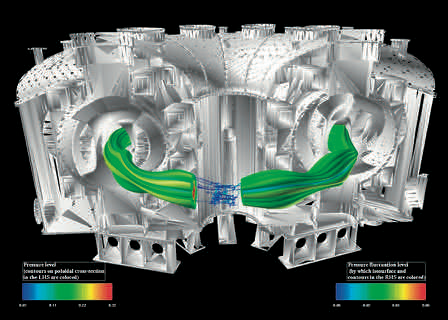

Interaction between energetic particles of LHD Plasmas and magnetohydrodynamic (MHD) modes
The interaction between the energetic particles and the MHD modes in fusion plasmas and the particle fluid hybrid simulations of this problem are studied. The interaction between the energetic particles and the MHD modes is a research issue of primary importance for burning plasmas where energetic alpha particles are created. The interaction involves interesting topics of plasma physics, such as MHD waves and Landau damping/growth.
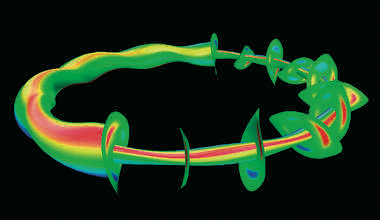
Turbulent transport phenomena in fusion plasmas
Understanding of turbulent transport of particles and heat is one of the central issues in fusion plasma research. In order to predict turbulent transport, we develop gyrokinetic simulations calculating turbulence in the five-dimensional phase space and aim to understand the physics of turbulence, which is a complex nonlinear dynamics of plasmas and exhibits self-organization, such as zonal flow production. By utilizing data of the gyrokinetic simulations in the five-dimensional space, we will construct a one-dimensional model that can be a part of a set of simulation codes for predicting the fusion plasma confinement.
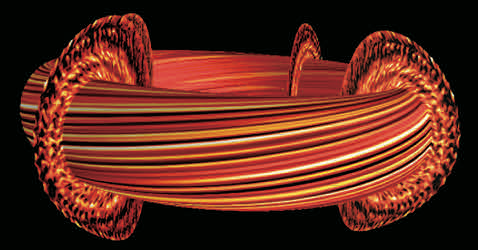
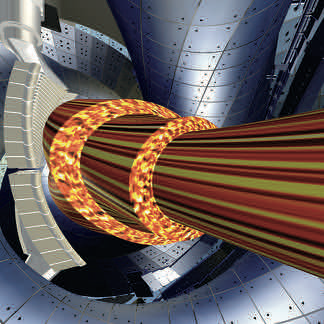
Research on the neoclassical transport phenomenon in fusion plasma
Complicated trajectories of charged particles confined in a three-dimensional magnetic torus, which are scattered by Coulomb collisions among the particles, produce the particle and heat flux called “neoclassical transport.” The aim of theory and simulation research on the neoclassical transport phenomenon is to evaluate the neoclassical transport, which strongly depends on the magnetic topology (tokamak, helical, etc.), plasma temperature, and density, as well as the ambipolar radial electric field which evolves spontaneously in torus plasmas. The neoclassical transport simulation is utilized to study the plasma confinement properties, the effect of the ambipolar electric field on the turbulent transport, the effect of the neoclassical viscosity on plasma rotation, and other topics.
Edge plasma transport in helical system plasmas
Edge plasma transports in the magnetically confined fusion plasma are studied by numerical simulations. In particular, the transport in the stochastic field of the three-dimensional magnetic configuration is considered. In our group, numerical simulation codes of heat, particles, neutrals, and impurities are being developed based on the fluid and drift kinetic models. The development of numerical schema for the edge plasma transport is also an important task.
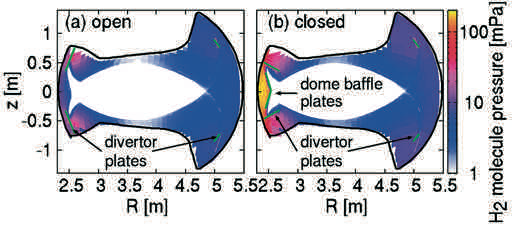
The simulation covers the stochastic region and also divertor legs.
Other main research topics
- Transport simulation in tokamak plasma
- Ablation simulation of solid hydrogen by multi-phase extension model of magnetohydrodynamics
- Extension of the magnetohydrodynamics equilibrium
- High-beta plasma simulation
- Theoretical analysis of magnetic field structure in the periphery region of LHD
Theoretical Analyses of Magnetically Confined Plasmas
It is a formidable challenge to reproduce all complicated behaviors of plasmas by direct numerical simulation at the present time, and in the future even if computer performance is greatly improved. Therefore, construction of theoretical models is indispensable to bridge the gap between simulation and reality. Here, research topics of theoretical analyses are presented.
Theoretical analyses of transport phenomena in fusion plasmas
Transport of particles and heat is studied analytically based on fluid equations in threedimensional space and on kinetic equations in five-dimensional space. Micro-instabilities driving turbulence and the production of mean flow reducing the instability are investigated by means of modern formulations with Lagrangian and Hamiltonian analyses, which are advantageous in utilizing symmetry and conservation properties of the equations. The reliable reduction from kinetic equations to fluid equations is also studied.
Theoretical Analysis Based on Magnetohydrodynamics
We are making progress in the field of MHD and confinement theories by utilizing fluid models of plasmas. In particular, we develop theories and numerical calculation schemes for extension of the analyses from static equilibria with isotropic pressure to equilibria with global flows and anisotropic pressure, spectrum analysis of linear MHD modes in both stable and unstable sides, inclusion of the flows and the spontaneous currents predicted by the neoclassical transport theory, and extension of the model equations by including the twofluid effects and kinetic effects in three dimensional magnetic configurations. We also discuss the validity of the theories by comparing the results with the experimental observations.
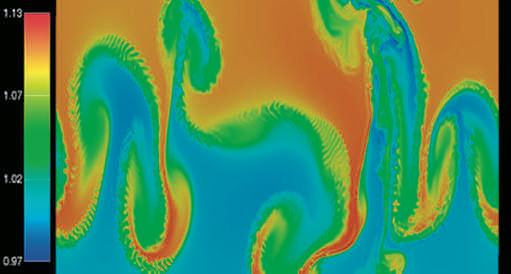
Transport analysis of improved confinement mode
The purpose of transport analysis is to clarify the physical mechanism of the electric field structure and the flow, which strongly affect the plasma confinement. To realize the nuclear fusion plasma, the transport of the improved confinement mode is studied. Due to the nonlinearity of the electric field determined by the neoclassical transport, the transition (bifurcation) phenomena are found in the electric field structure. The effect of the transition phenomena on the turbulence transport is studied by formulation and analysis, and we aim to achieve the improved confinement mode.
Complexity Plasma Simulation
Plasmas and other physical systems show common physical phenomena such as selforganization and intermittent energy release. We aim at the formulation of a novel theoretical framework by treating physical issues caused by complexity. Obtained knowledge can be applied to not only fusion plasmas but also to astrophysics and material science.
Dynamics of collisionless magnetic reconnection in the three-dimensional open system
We advance our research on the dynamics and self-organization phenomena of the structure formation in the plasma by large-scale simulation. For example, we study 1) the multi-hierarchy simulation model in which macroscopic and microscopic physics are expressed consistently and simultaneously on the collisionless magnetic reconnection, 2) the particle simulation on plasma instability and anomalous resistivity in the current sheet, 3) the dynamics of plasma structure formation in the energy open system, and 4) the physics of the structure formation and self-organization in the magnetic-confinement plasma, and other topics. We will provide education and advance the research in these fields.
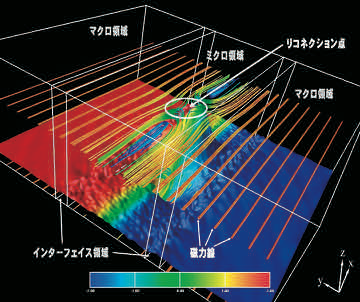
Research on basic plasma phenomena by means of particle simulations
We study basic physical processes of edge plasma by means of particle simulations. In particular, dynamics of plasma near solid wall and structural formation related to the interaction between plasma and neutral gas are investigated by using a supercomputer.
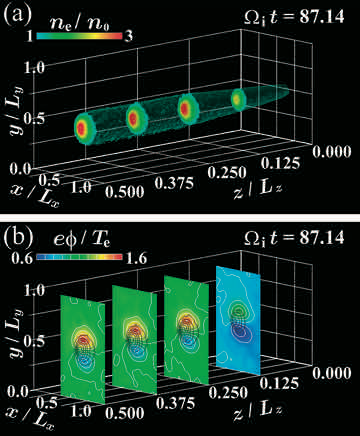
Research on plasma-material interaction on atomic-level simulation
The phenomena due to the plasma-material interaction (PMI) which is caused by the boundary region between plasma and the inner wall in the fusion reactor are investigated at atomic-scale by using numerical computer simulation. To simulate the PMI phenomena, it is necessary to develop the multiscale modeling composed of moleculardynamics (MD), density functional theory (DFT), binary collision approximation (BCA), and Monte-Carlo (MC) methods. Recent progress is the development of the hybrid simulation among these methods. The hybrid simulation enables us to treat the multi-physical processes in the PMI, such as the formation processes of a helium nano-bubble and a fuzzy nano-structure on the tungsten surface bombarded by helium plasma.
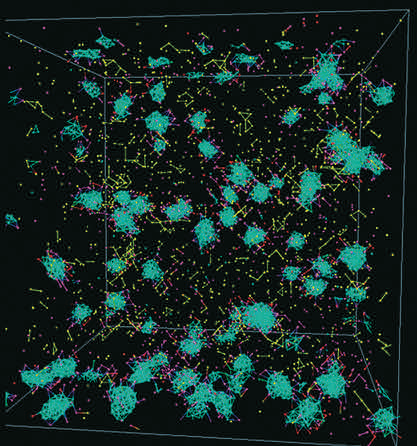
Other principal research topics
- Molecular dynamics simulation on the collision process between hydrogen and carbon material
- Particle acceleration by shock wave
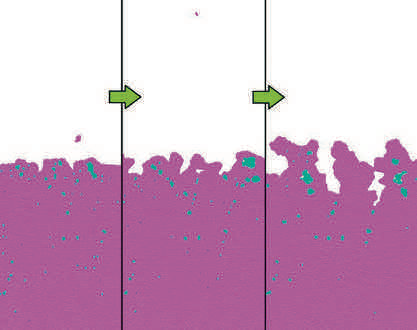
Development of Simulation Methods
In order to advance the simulation research it is necessary to address issues concerning the methods, for example, how to model numerically the real physical world, how to calculate such huge numerical data efficiently, and how to express the simulation results for understanding. This program also attaches great importance to the development of challenging simulation approaches that go beyond the framework of conventional methods.
Virtual-reality system
The numerical simulation results on various complex phenomena generally show very complex shape structures and behaviors spatiotemporally. We are investigating the immersive virtual-reality (VR) system which can display the complex structures in the three-dimensional space as they are. When the viewer wearing the exclusive glasses with the sensor comes into the room surrounded by four screens, the system makes the viewer feel as it s/he is in the simulation world feeling deep immersion, and this helps the intelligent thinking process. Using this system, we are attempting an implementation toward the optimization of the experimental device by re-creating an authentic-looking device in the VR world in addition to conducting research on understanding the complex structure in the numerical solutions.
Other principal research topics
- Construction of an advanced simulation system
- Development of a numerical calculation scheme with high accuracy and high efficiency
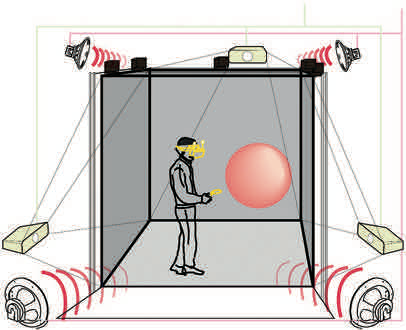
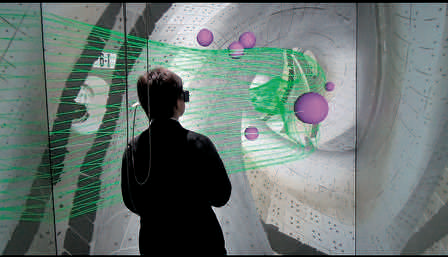
Plasma Simulator RAIJIN
In order to support the clarification and the systematization of the physical mechanisms of fusion plasma confinement, the search of complexity science as basic research which support them, and the collaborative research which establishes the simulation science, NIFS developed this system. Called “Plasma Simulator RAIJIN,” this is a composite system from the execution of the simulation to the data processing, including the above-mentioned VR system through the high-speed network in order to advance consistently and efficiently the collaborative research on simulation. The main massive parallel computer server is SX-Aurora TSUBASA (4,320 Vector Engines (VE)) by NEC, which was introduced in July 2020. The capacity of the main memory is 202 tebibytes and the computational performance is 10.5 petaflops.
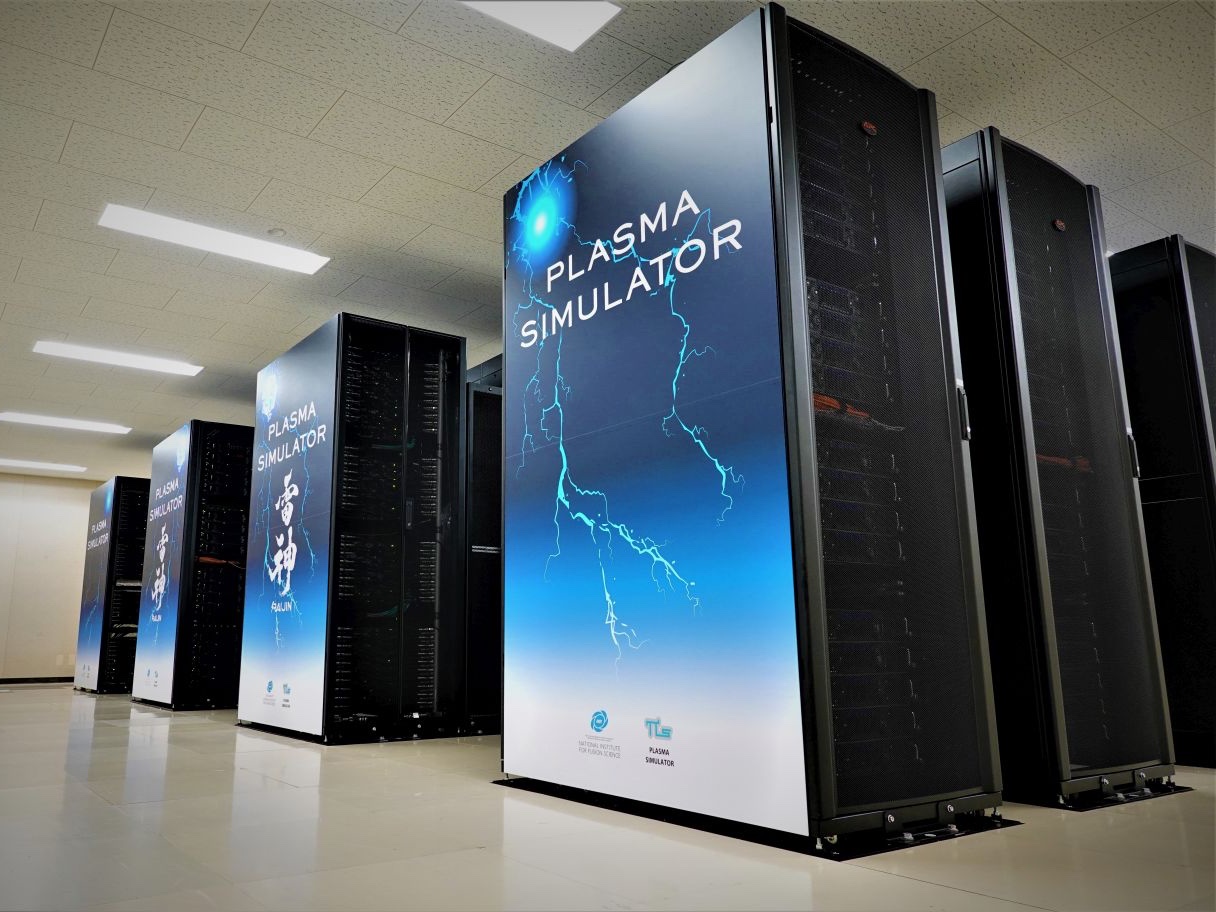
SX-Aurora TSUBASA
4,320 VEs
202 TiB (total VE main memory)
10.5 PFlops(total VE computational performance)

The effective capacity: 32.1 petabytes





